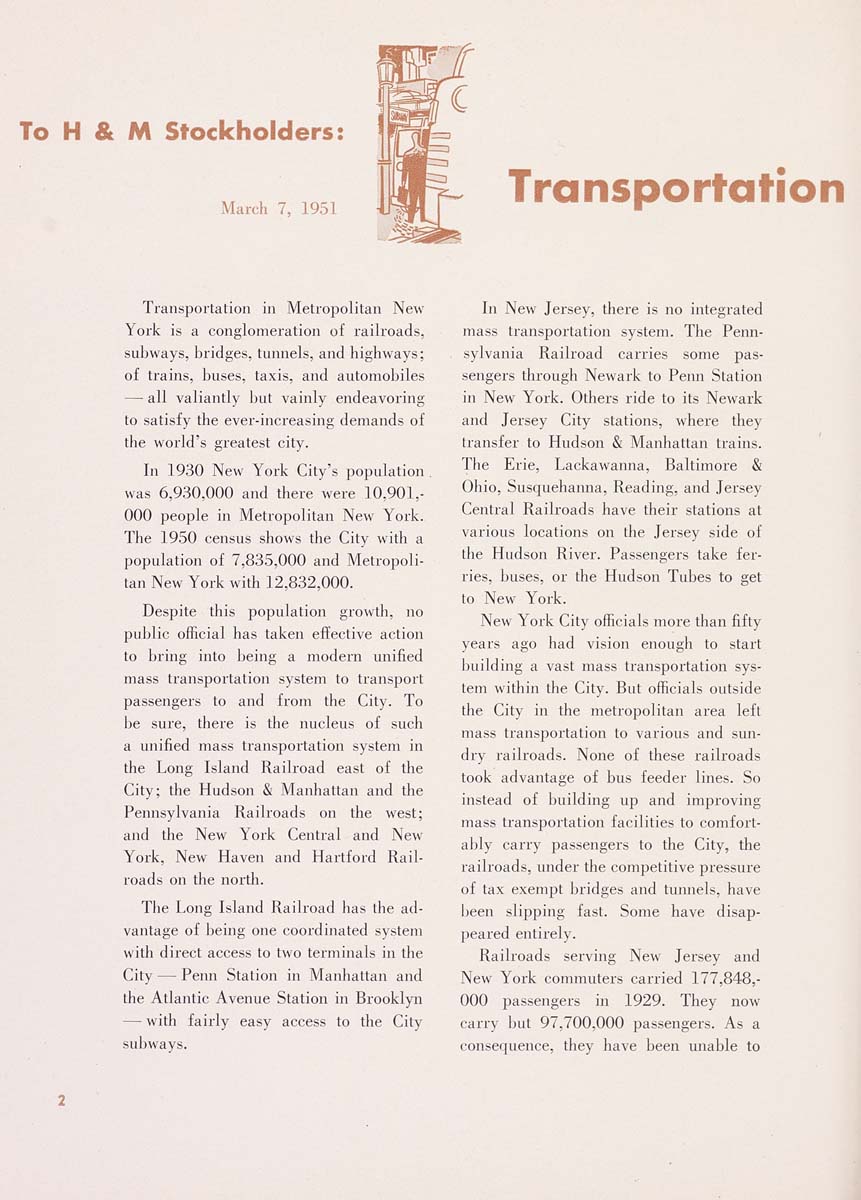Annual report of Hudson & Manhattan Railroad Company
(New York, N.Y. : Hudson and Manhattan Railroad Company )
|
||
|
|
|
|
| 1950: Page 2 |

To H & M Stockholders: Marcli 7, 1951 Transportation Transportation in Metropolitan New York is a conglomeration of railroads, subways, bridges, tunnels, and highways; of trains, buses, taxis, and automobiles —- all valiantly but vainly endeavoring to satisfy the ever-increasing demands of the world's greatest city. In 1930 New York City's population . was 6,930,000 and there were 10,901,- 000 people in Metropolitan New York. The 1950 census shows the City with a population of 7,835,000 and Metropoli¬ tan New York with 12,832,000. Despite this population growth, no public official has taken effective action to bring into being a modern unified mass transportation system to transport passengers to and from the City. To be sure, there is the nucleus of such a unified mass transportation system in the Long Island Railroad east of the City; the Hudson & Manhattan and the Pennsylvania Railroads on the west; and the New York Central and New York, New Haven and Hartford Rail¬ roads on the north. The Long Island Railroad has the ad¬ vantage of being one coordinated system with direct access to two terminals in the City — Penn Station in Manhattan and the Atlantic Avenue Station in Brooklyn — with fairly easy access to the City subways. In New Jersey, there is no integrated mass transportation system. The Penn¬ sylvania Railroad carries some pas¬ sengers through Newark to Penn Station in New York. Others ride to its Newark and Jersey City stations, where they transfer to Hudson & Manhattan trains. The Erie, Lackawanna, Baltimore & Ohio, Susquehanna, Reading, and Jersey Central Railroads have their stations at various locations on the Jersey side of the Hudson River. Passengers take fer¬ ries, buses, or the Hudson Tubes to get to New York. New York City officials more than fifty years ago had vision enough to start building a vast mass transportation sys¬ tem within the City. But officials outside tiie City in the metropolitan area left mass transportation to various and sun¬ dry railroads. None of these railroads took advantage of bus feeder lines. So instead of building up and improving mass transportation facilities to comfort¬ ably carry passengers to the City, the railroads, under the competitive pressure of tax exempt bridges and tunnels, have heen slipping fast. Some have disap¬ peared entirely. Railroads serving New" Jersey and New York commuters carried 177,848,- 000 passengers in 1929. They now carry but 97,700,000 passengers. As a consequence, they have been unable to |
| 1950: Page 2 |







